10 Biggest Secrets And Mysteries In The World Of All Time
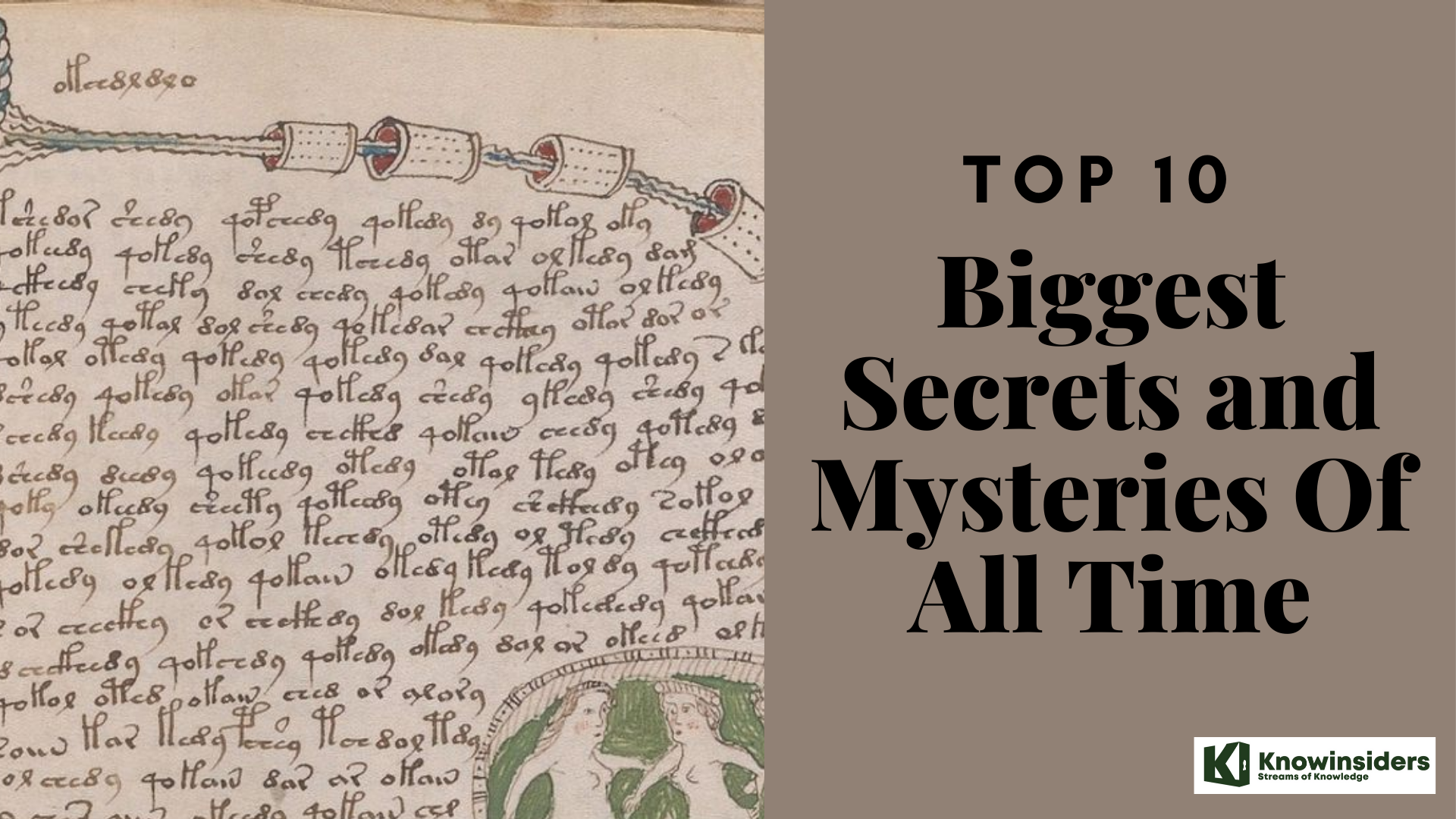 |
| Top 10 biggest secrets and mysteries of all time |
Few stories have the power to captivate us more than those that remain unresolved. Codes, puzzles and cryptic public art tease us with their intrigue: Why is their message coded? What great secrets might they hide? Despite the efforts of our most revered historians, cleverest cryptographers, and most determined treasure hunters, history is replete with riddles that continue to confound us today. Fictional tales like those featured in “The Da Vinci Code” and the movie “National Treasure” have got nothing on these real-life puzzles.
Here are the biggest secrets and mysteries in the world.
List of top 10 biggest secrets and mysteries in the world of all time
10. Rongorongo
9. Georgia Guidestones
8. The Zodiac letters
7. The Wow! Signal
6. Tamam Shud case
5. Shugborough inscription
4. Phaistos Disc
3. Beale Ciphers
2. Kryptos
1. Voynich Manuscript
What are the biggest secrets and mysteries in the world of all time?
10. Rongorongo
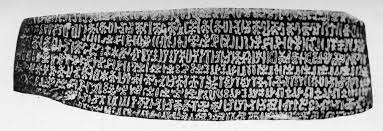 |
| Photo: Wikipedia |
Rongorongo is a form of writing or proto-writing discovered on Easter Island in the Pacific during the 19th century. It was first mentioned in a 1866 report by Eugène Eyraud, who landed on the island in 1864. Many attempts have been made to decipher the script, but none have so far been successful. Some symbols that are thought to represent dates and genealogical information have been identified, although nobody knows how to read them.
A few inscriptions appear carved into stones on Easter Island, and there are 26 wooden objects with texts in Rongorongo on them that were collected on the island during the 19th century. They are now in museums and private collections around the world. Only half of the texts are in good condition and are believed to be authentic. According to oral tradition the script was also written on banana leaves with obsidian flakes or small shark teeth, however no examples survive.
The name Rongorongo means "to recite, to declaim, to chant out" in Rapa Nui, the native language of Easter Island. This possibly comes from the expression kohau motu mo rongorongo (lines incised for chanting out).
It is not known when Rongorongo was invented or by whom. A few of the wooden tablets with inscriptions in have been dated, and the oldest dates back to the early 17th century.
Rongorongo was used until the 1860s, after which knowledge of the script was lost. However during the 1880s a group of elders devised a version of the script called ta'u to decorate carvings to make them more valuable.
Nowadays most Easter Islanders write in Spanish using the Latin alphabet though a few write their own language, Rapa Nui, also with the Latin alphabet.
9. Georgia Guidestones
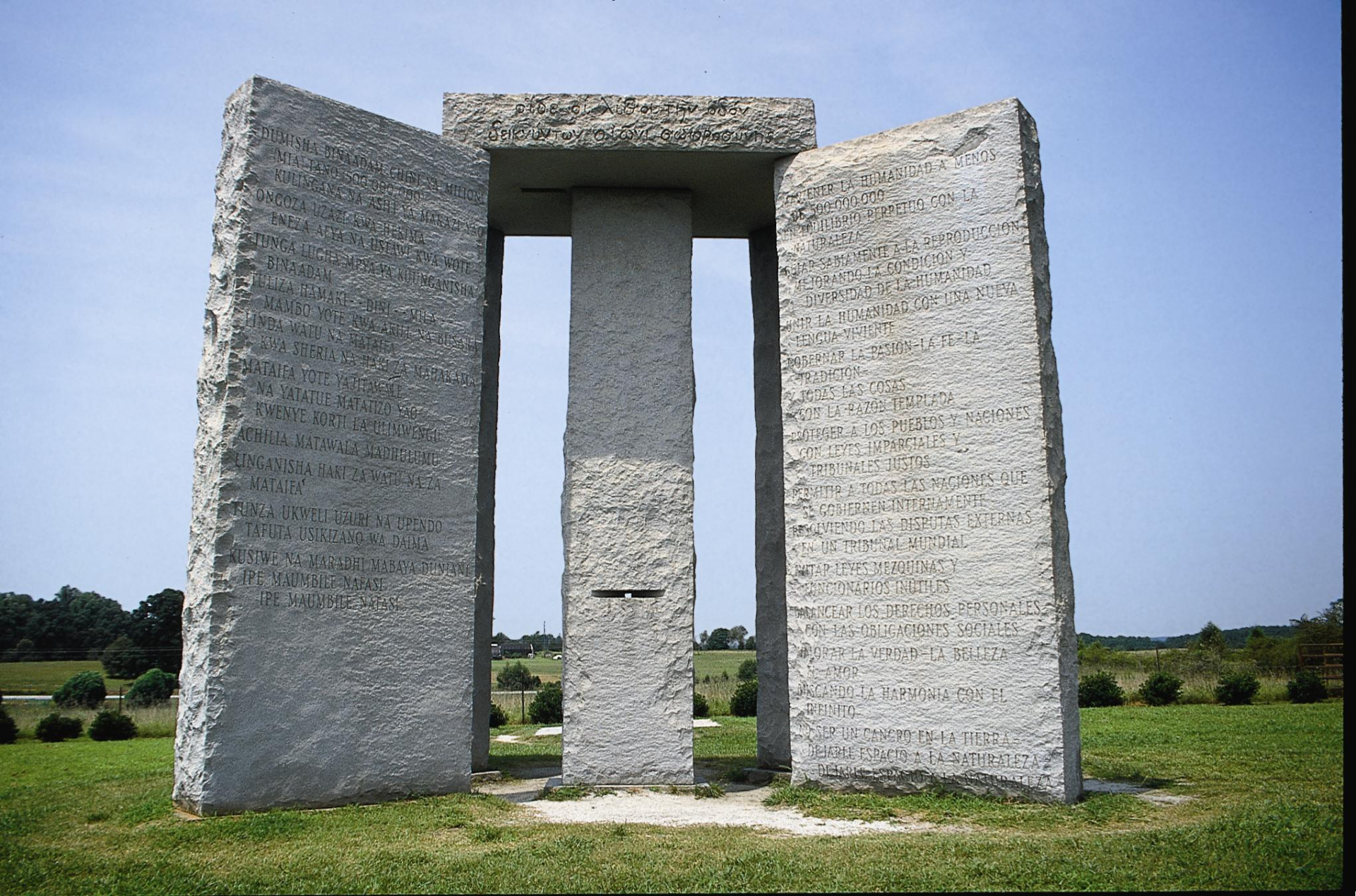 |
| Photo: Explore Georgia |
The Georgia Guidestones, Elberton's most unusual set of granite monoliths, poses a mystery for the numerous visitors who visit the site seven miles north of Elberton on Georgia Highway 77. Known as America's Stonehenge, this 19-foot high monument displays a 10-part message espousing the conservation of mankind and future generations in 12 languages. The Guidestones also serve as an astronomical calendar, and every day at noon the sun shines through a narrow hole in the structure and illuminates the day’s date on an engraving. The names of four ancient languages are inscribed on the sides near the top: Babylonian cuneiform, Classical Greek, Sanskrit, and Egyptian Hieroglyphics. The Guidestones are mysterious in origin, for no one knows the identity of a group of sponsors who provided its specifications.
Though the monument contains no encrypted messages, its purpose and origin remain shrouded in mystery. They were commissioned by a man who has yet to be properly identified, who went by the pseudonym of R.C. Christian.
Of the 10 commandments, the first one is perhaps the most controversial: "Maintain humanity under 500,000,000 in perpetual balance with nature." Many have taken it to be a license to cull the human population down to the specified number, and critics of the stones have called for them to be destroyed. Some conspiracy theorists even believe they may have been designed by a "Luciferian secret society" calling for a new world order.
 Top 10 Most Mysterious People In The World Top 10 Most Mysterious People In The World There are things on earth that we have never found out, as for the list of the 10 most mysterious people in the world right ... |
8. The Zodiac letters
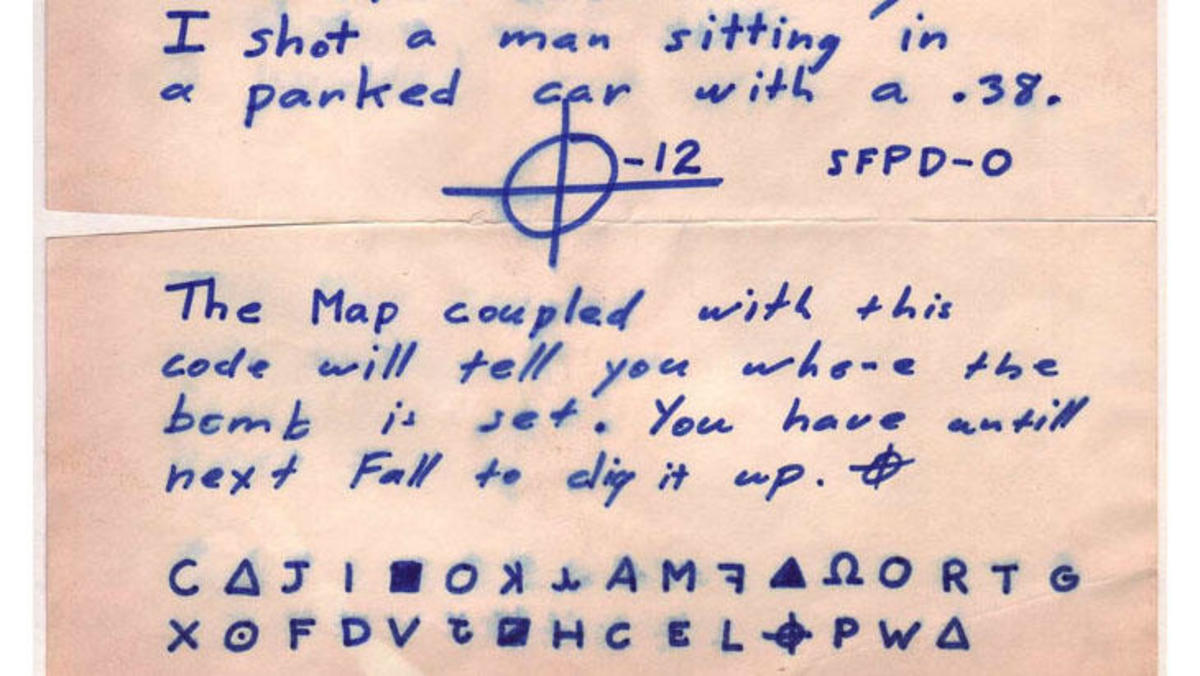 |
| Photo: History |
The Zodiac Killer, or simply Zodiac or the Zodiac, is the pseudonym of an unidentified serial killer who operated in Northern California in the late 1960s. The killer originated the name himself in a series of taunting letters and cards that he mailed to regional newspapers, threatening killing sprees and bombings if they were not printed. Some of these letters included cryptograms, or ciphers, in which the killer claimed that he was collecting his victims as slaves for the afterlife.
The Zodiac murdered five known victims in the San Francisco Bay Area between December 1968 and October 1969, alternating among rural, urban, and suburban settings. In chronological order, the known attacks took place in Benicia, Vallejo, unincorporated Napa County, and the city of San Francisco proper. He targeted young couples, with two of the men surviving attempted murder; he also killed a lone male cab driver. The Zodiac himself once claimed to have murdered 37 victims, and he has been linked to several other cold cases, some in Southern California or outside the state.
The San Francisco Police Department (SFPD) marked the case "inactive" in April 2004, but re-opened it at some point prior to March 2007. The case also remains open in the city of Vallejo, as well as in Napa County and Solano County. The California Department of Justice has maintained an open case file on the Zodiac murders since 1969.
A coded message sent by a brutal serial killer who has never been caught has been cracked more than 51 years after it was sent.
In November 1969, after killing the remaining two known victims, the Zodiac Killer sent a letter to the San Francisco Chronicle that included a new puzzle. The cryptogram was known as the Z-340, or simply the 340, because it contained 340 characters in it. The full image of the cryptogram appears below:
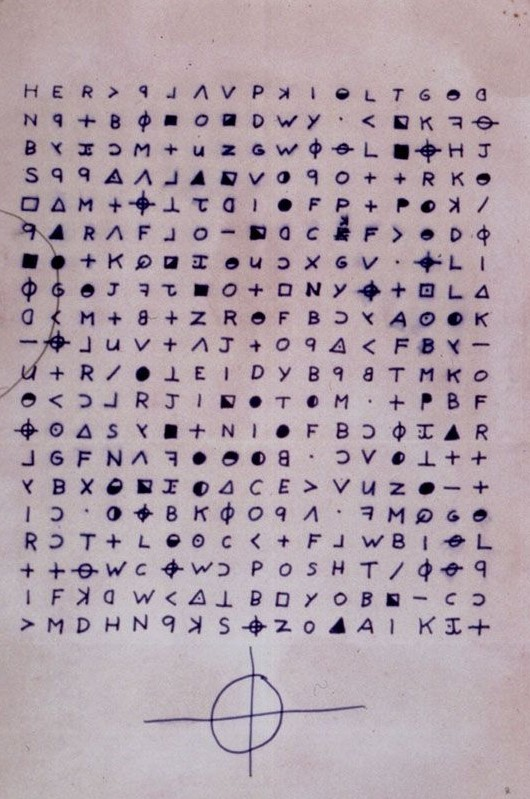 |
| Photo: San Francisco Police |
| “The cipher had been unsolved for so long, it had a huge target on its back, and I felt like it was a challenge that had a chance of being solved,” Dave Oranchak, one of the three men who cracked the encoded message, said by email. “It was an exciting project to work on, and it was on many people’s ‘top unsolved ciphers of all time’ lists.” The full text of the cracked cipher reads: I HOPE YOU ARE HAVING LOTS OF FUN IN TRYING TO CATCH ME THAT WASN’T ME ON THE TV SHOW WHICH BRINGS UP A POINT ABOUT ME I AM NOT AFRAID OF THE GAS CHAMBER BECAUSE IT WILL SEND ME TO PARADICE ALL THE SOONER BECAUSE I NOW HAVE ENOUGH SLAVES TO WORK FOR ME WHERE EVERYONE ELSE HAS NOTHING WHEN THEY REACH PARADICE SO THEY ARE AFRAID OF DEATH I AM NOT AFRAID BECAUSE I KNOW THAT MY NEW LIFE WILL BE AN EASY ONE IN PARADICE DEATH Oranchak, a 46-year-old software developer in Virginia, said the 340 is what’s known as a transposition cipher. Most ciphers used today by computers rely on mathematics to scramble messages. Transposition ciphers, by contrast, are largely relics from the past that use rules to rearrange the characters or groups of characters in the message. Transposition ciphers rearrange messages in a wide variety of ways. A common way is by rearranging columns of a message. The message in the 340 was probably rearranged by manipulating triangular sections cut from messages written into rectangles. Oranchak and his colleagues developed an app that helped him and his colleagues unravel the puzzle. Oranchak said he has been working on and off on solving the 340 since 2006. The other two men on the team are Sam Blake, an applied mathematician who lives in Australia, and Jarl Van Eycke, a warehouse operator in Belgium. Van Eycke is also the software developer behind the AZdecrypt, a code-breaking app that was inspired by his drive to crack the 340. |
7. The Wow! Signal
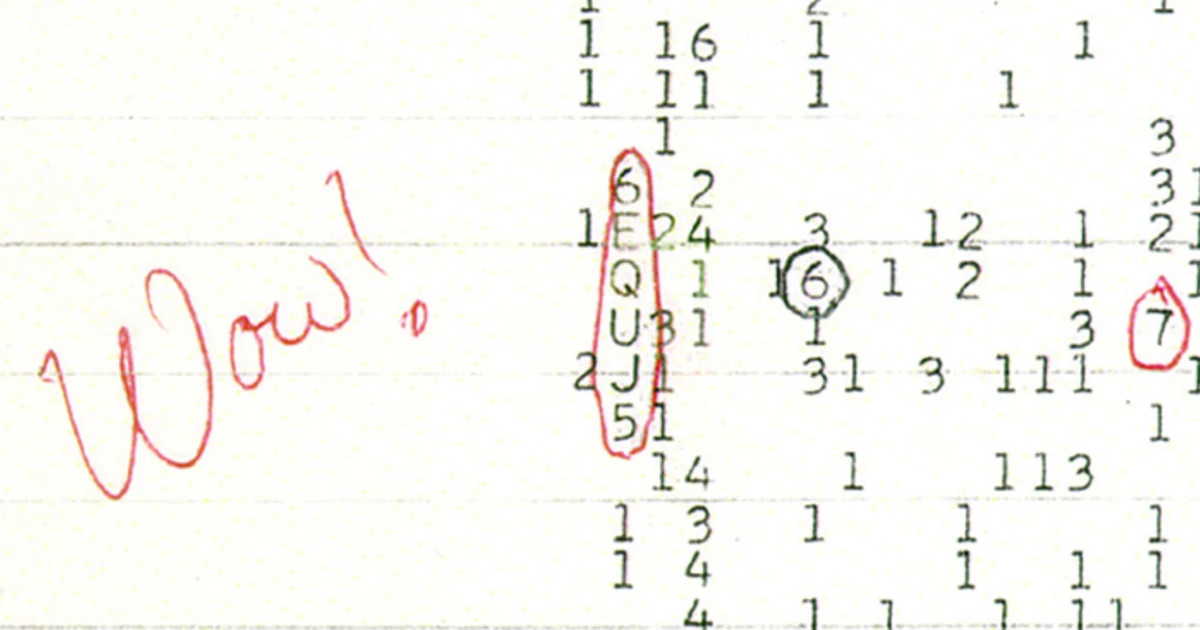 |
| Photo: NBC News |
On August 15, 1977, the Big Ear Radio Telescope in Delaware, Ohio, received the most powerful signal it would ever detect during its decades of observations. The signal lasted just 72 seconds, but when an astronomer spotted it on a computer printout days later, he was so impressed that he quickly scrawled “Wow!” in red pen across the page. The data looked much like what SETI astronomers expected to see from an alien intelligence. However, despite many attempts to follow up on the find, the so-called “Wow! Signal” has never reappeared.
Few moments in the search for extraterrestrial intelligence (SETI) have captivated the public’s imagination quite like the Wow! Signal. To some, it’s the most promising potential detection of alien life ever. But others see it as a triumph of publicity over science.
“Was that E.T. or was it not E.T.? Nobody knows,” Seth Shostak, senior astronomer at the SETI Institute, tells Astronomy. “Nobody has ever found another explanation for what that might have been. It's like you hear chains rattling in your attic and you think ‘My god ghosts are real.’ But then you never hear them again, so what do you think?” Most importantly, Shostak says that if the signal wouldn’t have had Wow! written across it, no one would’ve ever heard of it. One-off signals like this were common back in the early days of SETI, when observatory computers were too primitive to notify astronomers of discoveries in real time, or perform rapid-fire follow-ups.
But that hasn’t stopped astronomers from repeatedly returning to this patch of sky searching for the return of the Wow! Signal.
6. Tamam Shud case
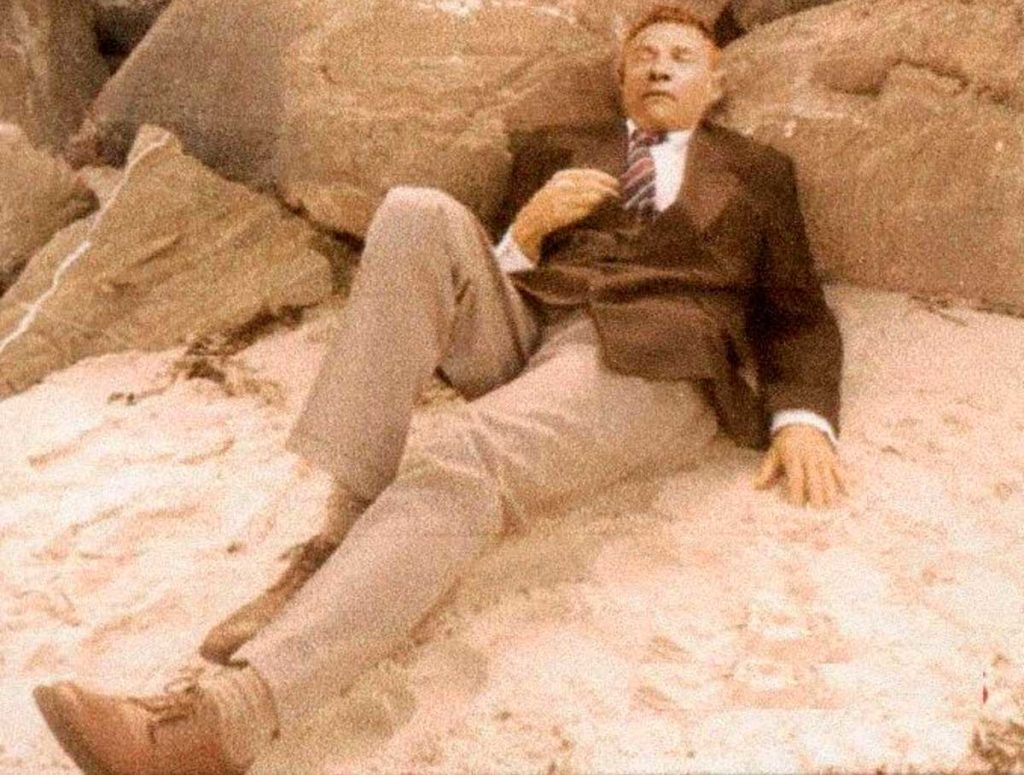 |
| Photo: Wikipedia |
A body was found on the shore of Somerton Beach. The man was not breathing. He was wearing a nice suit—a very formal wear—which was totally bizarre. No one knew who he was; he had no form of identification.
He was not one of the reported missing people. There was no clue who he was and the investigators just simply theorised that he died of natural causes while he was near the shore of the beach. It’s been more than 65 years people investigated this body over and over again but no one knows the answer to this puzzle.
It was seven o’clock in the afternoon, 1948, when a married couple passed by this old man’s body. They thought he was just drunk and so ignored and passed by. There was another group of people who passed by just a few minutes after, but they also ignored him. The next day, when the married couple came out to the beach once again, they realised that it was the same man lying there in the same spot. Suspecting that something was wrong, the married couple called 911 immediately.
The body was sent to Royal Adelaide Hospital and was carefully examined. According to the police, the following materials were all found in this man’s pocket: “an unused train ticket from Adelaide to Henley Beach, a bus ticket from Adelaide to Glenelg, a pack of Juicy Fruit chewing gum, some Bryant & May matches, an aluminum comb, and a pack of Army Club cigarettes containing seven cigarettes of another, more expensive brand called Kensitas.”
The autopsy that the doctors did the next day told several things. The doctor claimed that this man’s foot was oddly twisted, making the doctors predict that he often wore formal shoes like shoes with heels. Also, his liver was swollen and his pupils were smaller than normal. Doctors all predicted that this man was poisoned, but there was no poisonous substance found in his body, which surprised both doctors and the police.
Detective Sergeant Lionel Leane continuously investigated through everything he could but there were barely any positive outcomes. There was a clueless note in one of the items that this man had with him. This note, after investigators tried to solve it, came to conclusion that it meant “finished” or “ended”. What could this possibly have meant? How did this poor, unknown man die?
5. Shugborough inscription
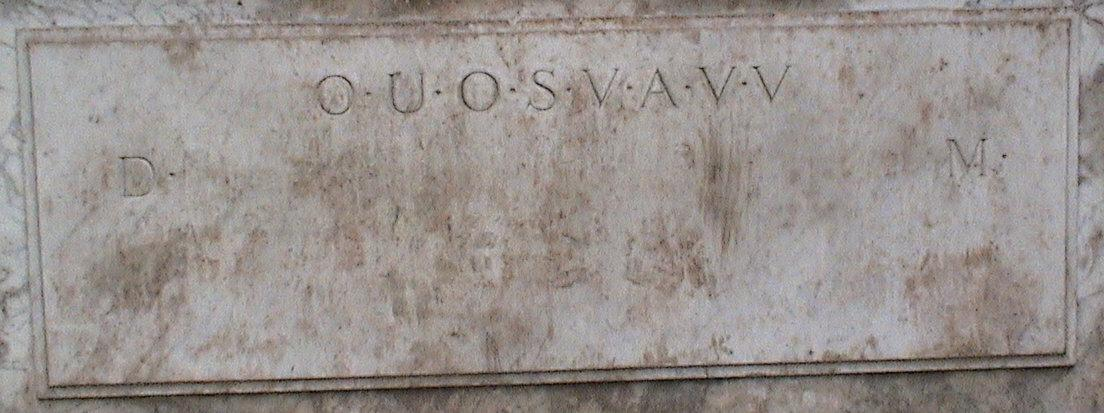 |
| Photo: Mysterious Trip |
The Shugborough inscription, which can be found on the 18th-century “Shepherd’s Monument,” has baffled scientists and linguists for many years.
The monument is located on the grounds of Shugborough Hall in Staffordshire, England.
Just below an engraving of Nicolas Poussin’s “Arcadian Shepherds” painting lies a seemingly random sequence of letters, “O-U-O-S-V-A-V-V,” etched on the monument between the letters “D” and “M.” Without an explanation for its meaning, the inscription is considered one of the world’s most perplexing ciphers and remains uncracked to this day.
The code’s uncrackable status may be in danger, though, thanks to Keith Massey, a linguistics expert, and Latin and Arabic teacher. He believes he found a convincing answer to the riddle which has stumped many geniuses throughout the ages, including Charles Dickens and Charles Darwin. The greatest minds of the 19th century tried to determine the meaning of the elusive enigma but gave up halfway through.
Massey, who was recruited by America’s National Security Agency after 9/11, used his vast knowledge of Latin to fill in the blanks. Massey theorizes that the seemingly ambiguous letters “O-U-O-S-V-A-V-V” may stand for “Oro Ut Omnes Sequantur Viam Ad Veram Vitam,” which translates to “I pray that all may follow the Way to True Life.”
“I believe I’ve solved the mystery. I believe my proposal provides a sensible and credible interpretation to this long-standing mystery,” states Massey, with high hopes that the code can now be stripped of its enigmatic shroud.
“My solution provides a straightforward and grammatical sentence, all parts of which are attested in tomb inscriptions and texts predating or contemporary with the creation of the Shugborough inscription.” He emphasizes the straight-to-the-point approach as an accurate method and advises not to look for any deeper meaning.
4. Phaistos Disc
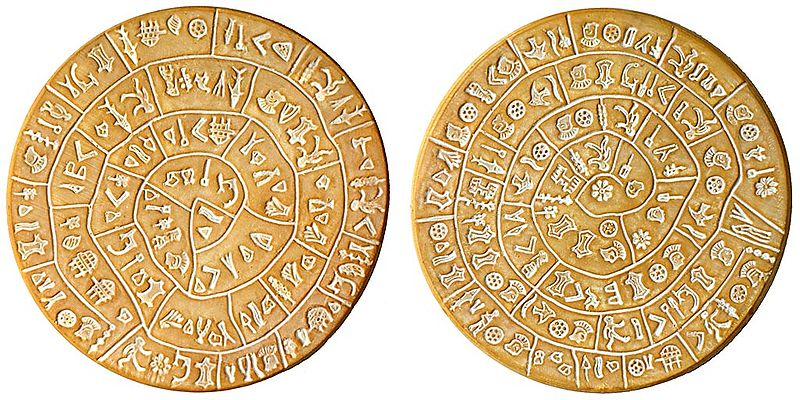 |
| Photo: Wikisource |
The Phaistos Disc (also spelled Phaistos Disk, Phaestos Disc) is a disk of fired clay from the Minoan palace of Phaistos on the island of Crete, possibly dating to the middle or late Minoan Bronze Age (second millennium BC). The disk is about 15 cm (5.9 in) in diameter and covered on both sides with a spiral of stamped symbols. Its purpose and its original place of manufacture remain disputed. It is now on display at the archaeological museum of Heraklion.
The disc was discovered in 1908 by the Italian archaeologist Luigi Pernier in the Minoan palace-site of Phaistos, and features 241 tokens, comprising 45 distinct signs, which were apparently made by pressing hieroglyphic "seals" into a disc of soft clay, in a clockwise sequence spiralling toward the center of the disk.
The Phaistos Disc captured the imagination of amateur and professional archaeologists, and many attempts have been made to decipher the code behind the disc's signs. While it is not clear that it is a script, most attempted decipherments assume that it is; most additionally assume a syllabary, others an alphabet or logography. Attempts at decipherment are generally thought to be unlikely to succeed unless more examples of the signs are found, as it is generally agreed that there is not enough context available for a meaningful analysis.
Although the Phaistos Disc is generally accepted as authentic by archaeologists, a few scholars believe that the disc is a forgery or a hoax.
3. Beale Ciphers
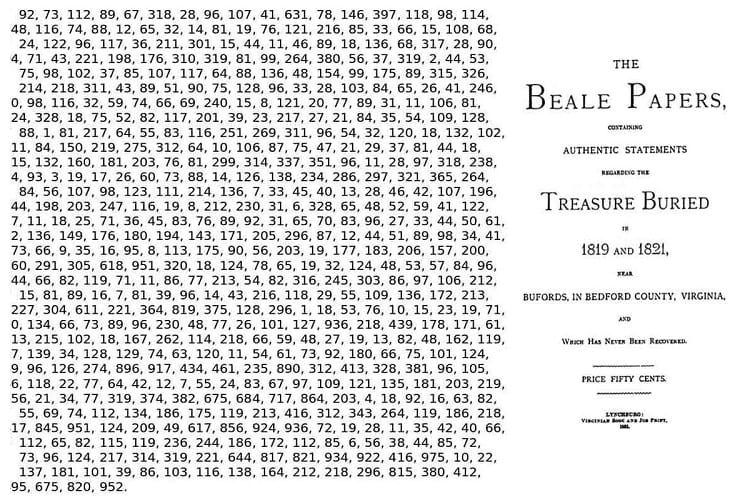 |
| Photo: STSTW Media |
The Beale ciphers (or Beale Papers) are a set of three ciphertexts, one of which allegedly states the location of a buried treasure of gold, silver and jewels estimated to be worth over US$43 million as of January 2018. Comprising three ciphertexts, the first (unsolved) text describes the location, the second (solved) ciphertext the content of the treasure, and the third (unsolved) lists the names of the treasure's owners and their next of kin.
The story of the three ciphertexts originates from an 1885 pamphlet detailing treasure being buried by a man named Thomas J. Beale in a secret location in Bedford County, Virginia, in the 1820s. Beale entrusted a box containing the encrypted messages to a local innkeeper named Robert Morriss and then disappeared, never to be seen again. According to the story, the innkeeper opened the box 23 years later, and then decades after that gave the three encrypted ciphertexts to a friend before he died. The friend then spent the next twenty years of his life trying to decode the messages, and was able to solve only one of them which gave details of the treasure buried and the general location of the treasure. The unnamed friend then published all three ciphertexts in a pamphlet which was advertised for sale in the 1880s.
Since the publication of the pamphlet, a number of attempts have been made to decode the two remaining ciphertexts and to locate the treasure, but all efforts have resulted in failure.
There are many arguments that the entire story is a hoax, including the 1980 article "A Dissenting Opinion" by cryptographer Jim Gillogly, and a 1982 scholarly analysis of the Beale Papers and their related story by Joe Nickell, using historical records that cast doubt on the existence of Thomas J. Beale. Nickell also presents linguistic evidence demonstrating that the documents could not have been written at the time alleged (words such as "stampeding", for instance, are of later vintage). His analysis of the writing style showed that Beale was almost certainly James B. Ward, whose 1885 pamphlet brought the Beale Papers to light. Nickell argues that the tale is thus a work of fiction; specifically, a "secret vault" allegory of the Freemasons; James B. Ward was a Mason himself.
2. Kryptos
 |
| Photo: Getty Images |
Kryptos is a sculpture by the American artist Jim Sanborn located on the grounds of the Central Intelligence Agency (CIA) in Langley, Virginia. Since its dedication on November 3, 1990, there has been much speculation about the meaning of the four encrypted messages it bears. Of these four messages, the first three have been solved, while the fourth message remains one of the most famous unsolved codes in the world. The sculpture continues to be of interest to cryptanalysts, both amateur and professional, who are attempting to decipher the fourth passage. The artist has so far given four clues to this passage.
The main part of the sculpture is located in the northwest corner of the New Headquarters Building courtyard, outside of the Agency's cafeteria. The sculpture comprises four large copper plates with other elements consisting of water, wood, plants, red and green granite, white quartz, and petrified wood. The most prominent feature is a large vertical S-shaped copper screen resembling a scroll or a piece of paper emerging from a computer printer, half of which consists of encrypted text. The characters are all found within the 26 letters of the Latin alphabet, along with question marks, and are cut out of the copper plates. The main sculpture contains four separate enigmatic messages, three of which have been deciphered.
In addition to the main part of the sculpture, Jim Sanborn also placed other pieces of art at the CIA grounds, such as several large granite slabs with sandwiched copper sheets outside the entrance to the New Headquarters Building. Several morse code messages are found on these copper sheets, and one of the stone slabs has an engraving of a compass rose pointing to a lodestone. Other elements of Sanborn's installation include a landscaped garden area, a fish pond with opposing wooden benches, a reflecting pool, and other pieces of stone including a triangle-shaped black stone slab.
The name Kryptos comes from the ancient Greek word for "hidden", and the theme of the sculpture is "Intelligence Gathering".
The cost of the sculpture in 1988 was US $250,000 (worth US $501,000 in 2016).
1. Voynich Manuscript
 |
| Photo: The Art Newspaper |
Named after the Polish-American antiquarian bookseller Wilfrid M. Voynich, who acquired it in 1912, the Voynich Manuscript is a detailed 240-page book written in a language or script that is completely unknown. Its pages are also filled with colorful drawings of strange diagrams, odd events and plants that do not seem to match any known species, adding to the intrigue of the document and the difficulty of deciphering it. The original author of the manuscript remains unknown, but carbon dating has revealed that its pages were made sometime between 1404 and 1438. It has been called "the world's most mysterious manuscript."
Theories abound about the origin and nature of the manuscript. Some, like historian and artist Nicholas Gibbs, believe it was meant to be a pharmacopoeia, to address topics in medieval or early modern medicine. In a recent essay for the Times Literary Supplement, Gibbs writes that it's "a reference book of selected remedies lifted from the standard treatises of the medieval period, an instruction manual for the health and wellbeing of the more well to do women in society, which was quite possibly tailored to a single individual.”
Many of the pictures of herbs and plants hint that it many have been some kind of textbook for an alchemist. The fact that many diagrams appear to be of astronomical origin, combined with the unidentifiable biological drawings, has even led some fanciful theorists to propose that the book may have an alien origin.
One thing most theorists agree on is that the book is unlikely to be a hoax, given the amount of time, money and detail that would have been required to make it.
 Top 10 Most Intelligent Animals On Planet Top 10 Most Intelligent Animals On Planet There are a lot of beautiful animals on our planet, and some of them demonstrate extraordinary abilities. Check out the 10 most intelligent animals in ... |
 Top 10 Best Educated Hollywood Actors Top 10 Best Educated Hollywood Actors There are several actors in Hollywood who have attained world acclaim for their superior acting skills and the ability to entertain world audiences. Check out ... |
 Top 10 Best Educated Hollywood Actresses Top 10 Best Educated Hollywood Actresses Some of the celebrities of hot and sexy women have achieved a high level of education. Check out right below the 10 best Hollywood actresses ... |
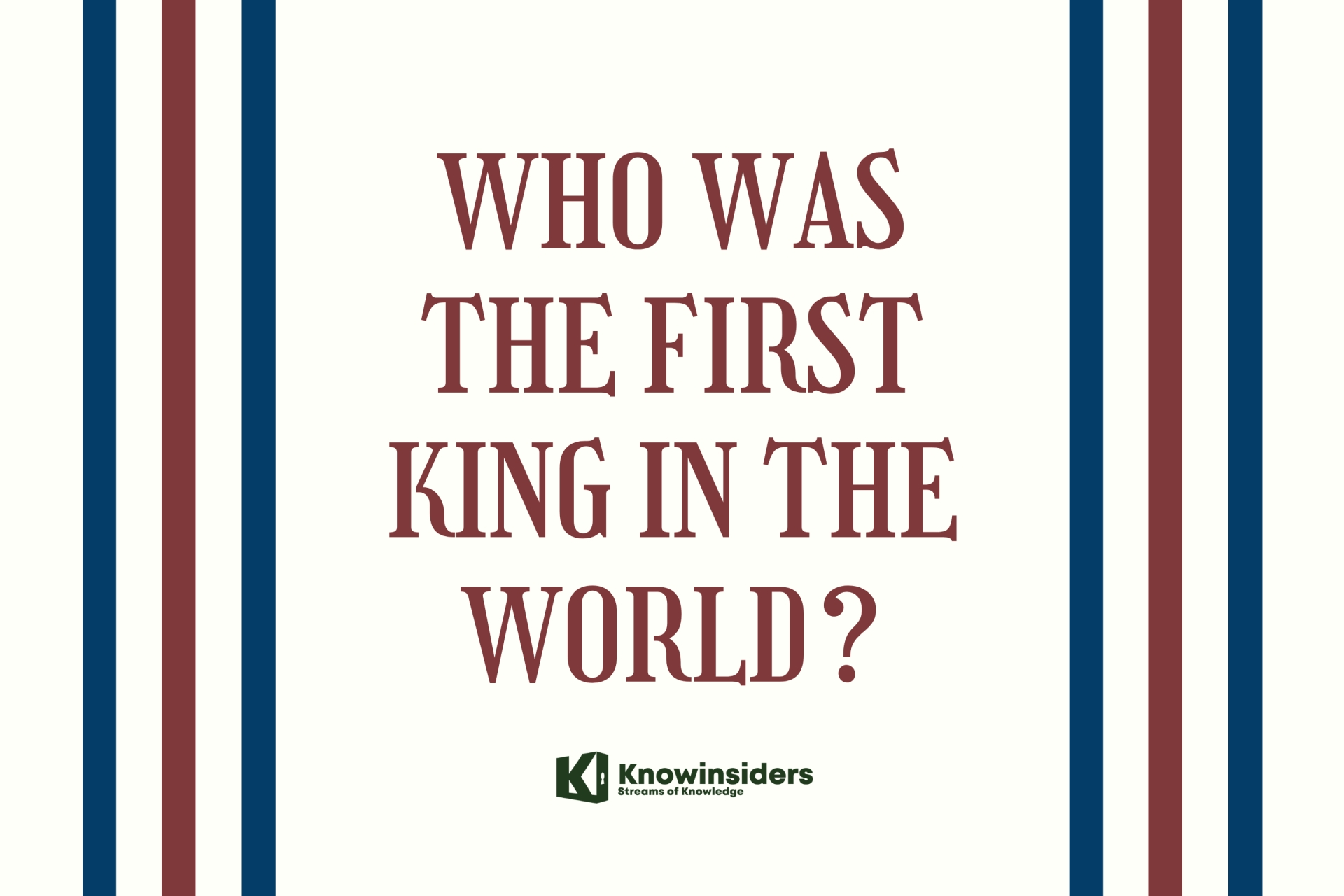 Who Was The First King And Top 10 Greatest Kings In The World of All Time Who Was The First King And Top 10 Greatest Kings In The World of All Time Who was the King of the first empire in the world’s history? Read on this article to know the answer. |


























